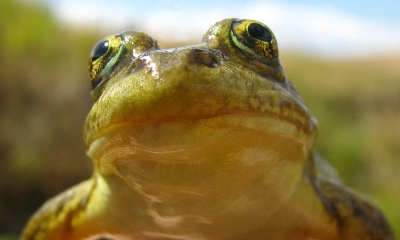
Frogs and Toads
Frogs and toads are found throughout Oregon, but usually not too far from streams or moist habitat.

Types of Frogs and Toads
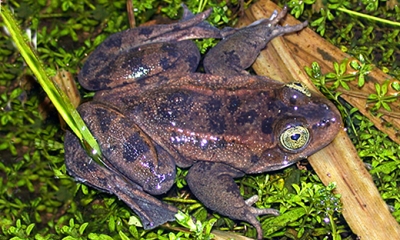
Adult Oregon spotted frogs have moist bumpy skin that is reddish-brown on their topsides. On their heads, backs, sides and legs, they have black spots with light centers that darken with age. They also have red bellies and orange-red underlegs. Adult females grow to four inches in length and males to three inches.
Oregon spotted frogs live in wet areas that provide abundant aquatic vegetation such as marshes, permanent ponds, lake edges and slow streams. When frightened, they hide in dense vegetation or under debris at the bottom of shallow wetlands. Adult frogs hibernate during the winter in freeze-free seeps, springs and channels (sometimes in mud bottoms at least one foot under water) connected to their breeding waters.
The Oregon spotted frog is an Oregon Conservation Strategy Species in both the East and West Cascades ecoregions.
Photo from ODFW
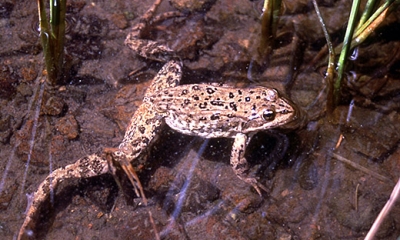
Adult frogs have moist bumpy skin that is tan or olive-green colored on their topsides. On their heads, backs, sides and legs, they have dark spots with light centers that darken with age. They also have red bellies and orange-red underlegs. Adult females grow to four inches in length and males to three inches in length.
Columbia spotted frogs live in wet areas that provide abundant aquatic vegetation such as marshes, permanent ponds, lake edges and slow streams. When frightened, they hide in dense vegetation or under debris at the bottom of shallow wetlands. Adult frogs overwinter in springs, spring-fed water holes, beaver dams, pond bottoms and some areas of permanent streams. They may actively move in cold water through the winter in ponds that ice over during the winter.
Columbia spotted frogs are an Oregon Conservation Strategy Species in the Blue Mountains and Northern Basin and Range ecosystems.
Photo from ODFW
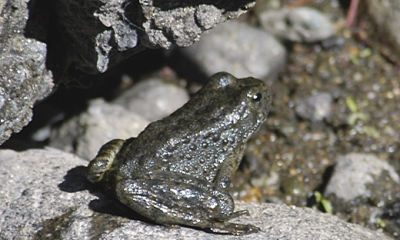
Adult frogs are gray or brown with yellow underbellies and thighs. Their color and grainy textured rough-looking skin helps camouflage them, making them hard to see among rocks. Adults can grow to three inches in length; males are slightly smaller than females.
Foothill yellow-legged frogs live in or along edges of permanent streams and rivers with exposed rocky streambeds and off-channel waters that are slow flowing and quiet. In summer, they are likely to hide under rocks in streams or among clumps of vegetation along pools. They use rocks or debris at the bottom of the streams as refuge from predators. They may wander out of their aquatic habitats on wet days. During times of cold weather, these frogs become inactive and usually reduce their level of activity during hot, dry weather.
The Foothill yellow-legged frog is an Oregon Conservation Strategy Species in several ecoregions - the Coast Range, Klamath Mountains, West Cascades and Willamette Valley.
Photo from ODFW
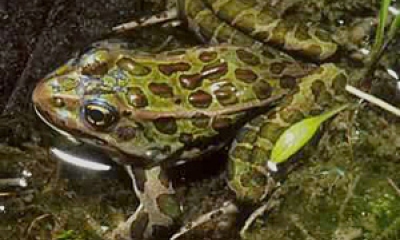
Adult Northern leopard frogs have smooth skin that is green or brown and covered with dark brown spots outlined with white rings. Females grow to just over four inches in length; males are slightly smaller at just over three inches.
They live in and near various water sources with abundant vegetation such as wet meadows, marshes, riparian areas and moist, open woodlands. These frogs use the vegetation, such as grasses, sedge, weeds or brush, as cover from predators. During the winter, they need ponds or slow-running streams for hibernation.
Photo from ODFW
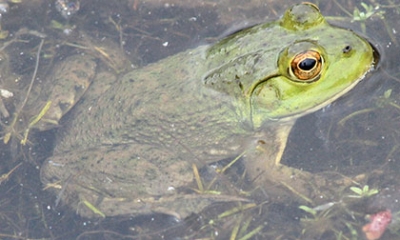
The American bullfrog is a non-native invasive frog that survives and reproduces very successfully in Oregon.
Bullfrogs aggressively compete for food and living space with our native frogs. They eat many types of native wildlife including other frogs, young pond turtles, and ducklings. Bullfrogs can lay almost 10 times more eggs than native frogs and can quickly out number them.
Photo by Kathy Munsel
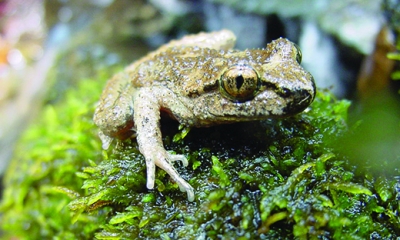
The coloring of adult coastal tailed frogs often matches the color of local rocks ranging from brown or reddish-brown to gray with little flecks of yellow or gray. They have grainy textured skin that further enhances their camouflage. Male coastal tailed frogs have a short tail, the signature for tailed frogs. Adult males grow to one and three-quarter inches long and adult females to two inches long.
They live in very shallow and heavily shaded water of fast running, small, permanent mountain streams with cold and clear water, rocky substrates and little silt in older forests. These streams are often fishless headwater streams. During rainy weather, adults may venture onto stream banks or away from streams into areas that would otherwise be too dry. Adults spend their days hiding under streambed rocks.
The coastal tailed frog is an Oregon Conservation Strategy Species in the Coast Range, Klamath Mountains and West Cascades ecoregions.
Photo by Brome McCreary
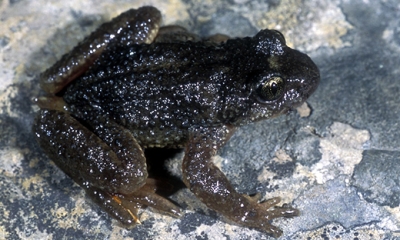
The Rocky Mountain tailed frog’s coloring often matches the color of local rocks ranging from brown or reddish-brown to gray. They have grainy textured skin that further enhances their camouflage. Males have a short tail, the signature for tailed frogs. Adult males are slightly smaller than adult females that grow to two inches in length.
Rocky Mountain tailed frogs are found in the water or close by it. They live in very shallow and heavily shaded water of fast-flowing, small, permanent streams in older mountain forests with cold and clear water, rocky substrates and little silt. These streams are often fish-less headwater streams. During rainy weather, adults may venture onto stream banks or away from the streams into areas that would otherwise be too dry. In the summer, adults hide under rocks in streams.
The Rocky Mountain tailed frog is an Oregon Conservation Strategy Species in the Blue Mountains ecoregion.
Photo from ODFW

The Great Basin spadefoot is a species of toad. Adult spadefoots are gray with light lines along the back and light colored bellies. Their skin has abundant dark colored small bumpy spots. They have a single, black, hard spade on the heel of each hind foot. Adult females are larger than males, growing to two-and-a-half inches in length.
Great Basin spadefoots live in dry sagebrush, grasslands and woodlands with sandy soils near ponds. Though they live in semi-arid habitats, they love the rain and damp weather. They spend most of the year in underground burrows that they dig quite efficiently using the spade on their hind foot. They use these burrows for hibernation during cold dry winters and estivation during hot dry summers.
Photo by James Bettaso

These large toads are well camouflaged in earth tones with dry bumpy skin that aids in protection from predators. Their color can be highly variable among individuals ranging from gray or reddish-brown to yellow or green. They have a light colored stripe that runs along the center of the back. Adult female toads are larger than males, growing to five inches in length.
They live mainly on land in a range of habitats from forests to mountain meadows to desert flats. During the non-breeding season, they are nocturnal. They dig their own burrows in loose soil, use existing burrows or hide under logs, other woody debris and rocks for daytime cover.
Western toads are Oregon Conservation Strategy Species in six of the nine ecoregions: Blue Mountains, Coast Range, East Cascades, Klamath Mountains, Northern Basin and Range, West Cascades.
Photo from ODFW

These large toads have bumps on their dry skin which contain poison glands to discourage predators. Color varies between individuals ranging from gray or yellow to dark brown. They have thin white stripes along their backs and yellow bellies with dark specks. Females are larger than males and grow to five inches in length.
Woodhouse’s toads live in river valleys in sagebrush and grassland habitats. They rest in burrows throughout the daytime hours and use wetlands during the breeding season. During dry weather, they burrow underground.
Photo by Cameron Sponseller
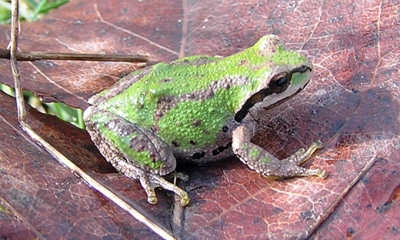
Adult treefrogs have a dark mask that extends from the tip of the nose across the eyes to the shoulders. Coloration varies between individuals, ranging from green or reddish to brown or gray. Most have dark blotches along their sides with light colored bumpy undersides.
They have special skin glands that produce a waxy coating to keep their skin moist. Male treefrogs have a dark gray, inflatable throat pouch during the breeding season. As the smallest frog species in Oregon, adult Northern Pacific treefrogs only grow to two inches in length.
During the non-breeding season, this treefrog is found in various habitats that can be quite distant from water, including wet meadows, riparian areas, woodlands and brush habitats and pastures and disturbed areas. They may even find shelter in tree cavities. Individuals living east of the Cascades move into underground burrows dug by other animals or stay in streams or springs during times of dry weather. They are inactive during freezing weather.
Photo by Susan Barnes, ODFW
More detailed information on Northern Pacific treefrog can be found here.
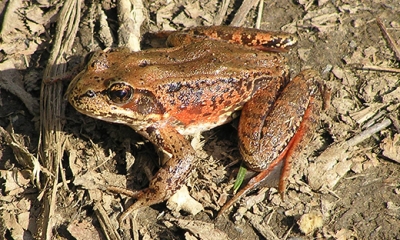
Adults have smooth, moist skin that is brown or reddish-brown in color with black flecks on their backs, sides and legs. They may also have a dark colored mask. Adults have red underlegs, hence their name. Females, growing to four inches in length, are almost twice the size of males.
Adult red-legged frogs like cool damp coniferous or deciduous forests and forested wetlands. During the non-breeding season, adult frogs spend most of their time on land in woodlands along streams, in moist sedge or brush, along shaded pond edges or under logs and other forest debris. Damp weather permits them to venture away from their primary water source into areas that would normally be too dry. They are inactive if temperatures are too cold or weather is too hot and dry. Coastal populations may remain active throughout the year.
Northern red-legged frogs are Oregon Conservation Strategy Species in these ecoregions: the Coast Range, Klamath Mountain, West Cascades and Willamette Valley.
Photo by Don Vandeburg, ODFW
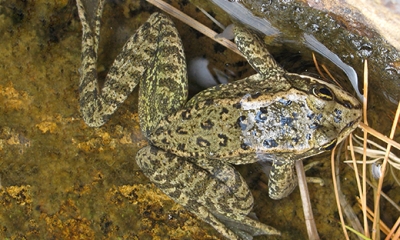
Adult Cascades frogs have tan, copper or green backs with black spots and yellow bellies. Their skin has small bumps on the back and sides. Females, which grow to three inches in length, are slightly larger than males.
Cascades frogs live in a variety of moist habitats including mountain meadows, bogs, seasonally flooded forested swamps and shallow ponds, marshes and lakes. They use woody debris, mud or dense vegetation for cover from predators and spend their winters hibernating in mud. They emerge during the summer and live in wet meadows and bogs or along forested streams and pond edges.
The Cascades frog is an Oregon Conservation Strategy Species in both the East and West Cascades ecoregions.
Photo by Simon Wray, ODFW

